Terminal decline

Terminal decline is what I experience at 2 am on a Friday morning as I put the finishing touches to the current week's post scheduled for that afternoon.
At best, it manifests itself as a mild headache and feeling of numbed satisfaction as I correct the last of the typoes and drop the images into place.
At worst, it leaves a mirrored impression 'RTYUIO' on my forehead as I slump, semi-comatose, onto the keyboard.
Why 2 am?
Why not write during daylight hours? After all, at this time of year there are lots of them. Civil twilight (essentially when artificial light is not needed outdoors) starts and ends at 3:30 am and 11:15 pm today in my part of the world.
There's a lot to do during these long summer days, and I'd prefer to be outside doing it rather than pecking away at a keyboard.
In particular, there's a lot of beekeeping to do.
I'm recently back from three wonderful sun-filled days of beekeeping in Fife; doing a demonstration (more "Whatever you do, don't do it like this", than "Free the caged queen and workers!") in an association apiary, checking lots of hives for newly emerged and mated queens, grafting the next round of queens and lifting a ton of supers on and off the hives.
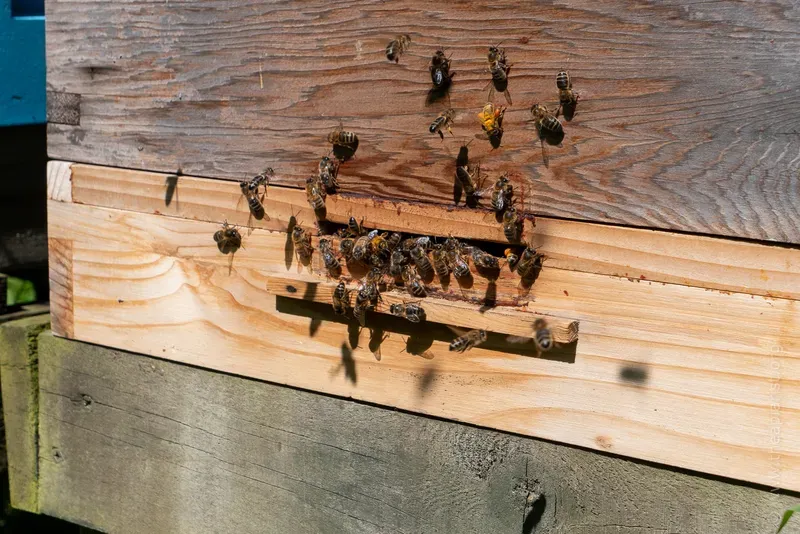
'Ton' might be an overestimate, but they were reassuringly heavy {{1}}. There was still wet nectar dripping out of the frames and yellow bees returning from the last of the oil seed rape (OSR), so it will be at least another week before I can start removing supers for extraction.
Not that sort of terminal decline
Although not yet high summer, it's probably the peak of the beekeeping season ... at least in terms of colony strength, in the ease (and speed) with which queens get mated, and in how 'forgiving' colonies are when we make beekeeping mistakes.
With good levels of forage, ample brood, reasonable weather, productive queens, lots of drone etc. even my most cack-handed errors are usually readily corrected.

And, potentially the most serious of these is the loss of a queen and, due to incompetence, accident, karma or whatever, the colony being left in the situation when it cannot rear a replacement.
The colony is then terminally queenless.
With no brood young enough to 'reprogram' as a queen, without intervention, the colony goes into terminal decline. There are changes to the behaviour of the bees in the colony, to the brood reared, and to their longevity.
And, in its broadest sense, the 'colony' includes both the bees and the pathogens and parasites that co-exist with their hosts (the bees).
A recent scientific study from Michael Smith (Smith & Peck, 2023) has investigated this terminal decline - the death spiral - of queenless colonies.
It's a worthwhile topic to visit now - at the height of the season - firstly, because it's not the cheeriest subject, but we'll soon be beekeeping again and so can put it to the back of our minds; secondly, to remind us what (some of) our colony interventions are intended to avoid; and thirdly, because when it happens - and it happens more than you might think - it has implications for other nearby colonies.
How does a colony become terminally queenless?
Tom Seeley's studies of bees in the Arnott Forest show that the survival rate of swarmed colonies (i.e. the colony from which the swarm leaves) is about 80%.
Although this study was conducted in temperate forests in the USA, I'm reasonably comfortable assuming that the survival rate of swarmed colonies in other regions is broadly similar.
As I discussed earlier this year, the number of free-living honey bee colonies may well be underestimated and could exceed managed colonies globally. In the UK, the situation is probably reversed, but there are still predicted to be ~70,000 free-living colonies.
Since the majority of these colonies probably swarm each year (again, data from Seeley; see his excellent book "The Lives of Bees"), even a 20% failure rate - swarmed colonies that do not survive - is a lot of colonies.
Of course, those 20% will not all fail due to queenlessness.

Some of the failures will be because the tree they were in fell down, or they were robbed out by honey badgers {{2}}, or they starved overwinter after successfully requeening.
But a proportion will fail to requeen themselves.
Who hasn't done this?
And the same thing happens to managed colonies.

During swarm control you remove the old queen, wait a week and then knock back all but one of the sealed queen cells present. The queen emerges and then - for whatever reason (swallows, swifts, house martens, the eponymous bee-eater, or she just gets lost) - fails to return.
Unless the beekeeper intervenes, the colony is doomed.
Surprisingly (to me at least) we have some real data on how frequent this is; terminal queenlessness has been recorded at 4-12% in the Arnott Forest (Ratneiks, 1990; Smith, 2018) and up to 53% during the bee-eater migration in Saudi Arabia (Abdu et al., 2012).
Alternatively, and not unusually with an inexperienced beekeeper, the discovery of swarm cells in the colony triggers an orgy of 'cell squidging'.
Every frame is minutely scrutinised after shaking the bees off.
Anything that looks even vaguely like a queen cell is 'mercilessly mashed'.
Nothing escapes.
That will stop them swarming!
Well, it might, but did you see the queen? What about eggs and larvae?
Oops 🤔.
If there was no queen, only sealed queen cells, and there were no eggs or young larvae present in the hive, then the colony swarmed some time ago.
With no eggs or larvae, there's nothing to use as the starting material to rear a new queen from.
That's when the colony goes into terminal decline ... and Smith and Peck studied what happens.
Watch and learn
Four colonies were established in observation hives that allowed each face of the four frames they contained to be examined. Observation hives were set up on the 1st of September and were maintained in a heated room to avoid most problems with thermoregulation as the season cooled.
The colonies were small - two frames of brood in all stages, a frame of drone comb and a frame of stores, together with two frames of bees of mixed ages.
The studies were conducted in Ithaca, NY (42°N), and started during a period when swarming normally occurs. Since late season robbing can be an issue (though it was not seen in this study) it was disappointing that the proximity of other colonies was not mentioned.
Ten days after establishing the colonies, any queen cells produced were destroyed, rendering them terminally queenless. Subsequent monitoring was by direct observation (through the glass, or using a sticky board under the open mesh floor) rather than by opening the hive.
It's worth noting that the size and organisation of the colonies, the fact that they were not created 'simply' by removing the queen, the time of year, and the local environment, could individually or jointly influence the results.
Queenless colonies survive a surprisingly long time
Regular readers will remember that the average lifespan of a worker bee is remarkably short, and probably no more than 28 days. It is therefore notable that the colonies survived an average of 86 days. The bee survival curves had a 'long tail', meaning that a small number of bees lived much longer than others, perhaps best illustrated as the proportion of survivors over time.
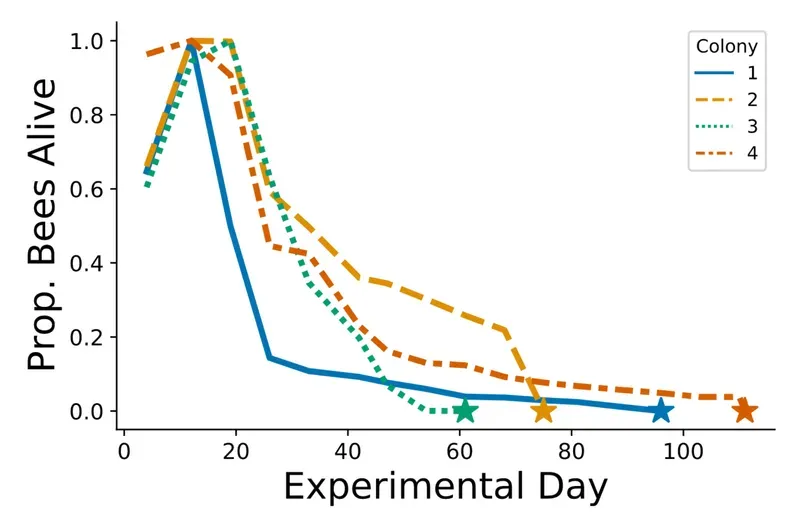
Overall, 50% of workers perished within 25 days, with 95% gone by day 74. Three of the colonies eventually died of starvation, the one that didn't appears to have succumbed to the cold.
Remember that this study was conducted from September to December in the Northern Hemisphere. Typically, long-lived winter bees would be produced during this period, but it seems unlikely (though not addressed in the discussion) that many would be present when the colonies were established.
This suggests that the longevity of 'normal' workers increases as a consequence of the colony becoming terminally queenless.
Laying workers
With no queen, the individual bees in the colony are doomed. Not only will the bees perish, but their genetic lineage is also threatened (and, in reality, almost certainly doomed).
This is why terminally queenless develop laying workers, i.e. worker bees that lay unfertilised eggs that (may) develop into drones {{3}}.
All colonies contain a low proportion of laying workers. This activity is suppressed by brood pheromones produced by open brood, and worker policing ensures that the 99.9% of worker-laid eggs are cannibalised.
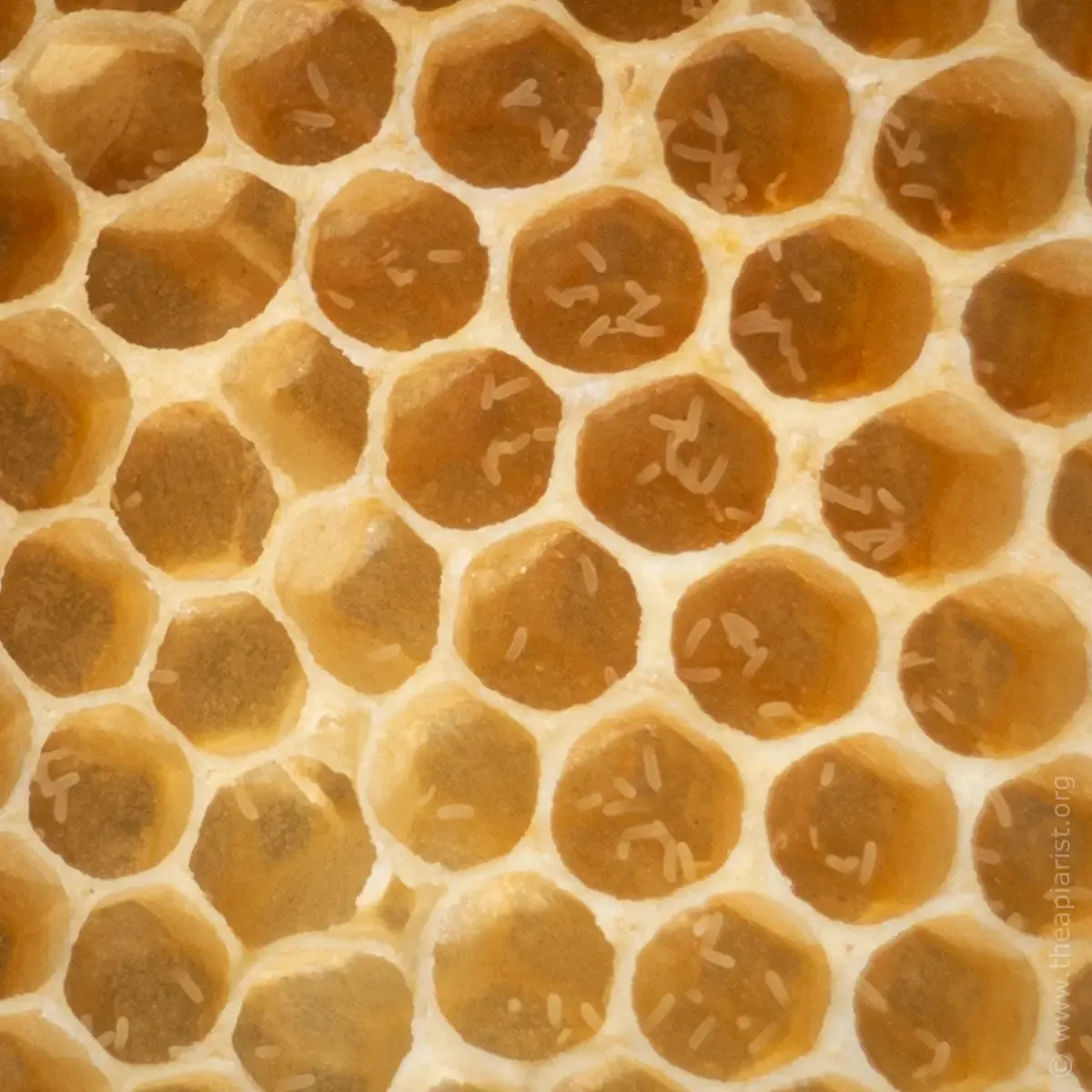
The development of laying workers always seems to catch me by surprise ... a colony can be queenless for a long period without an issue and then, BOOM!, multiple eggs everywhere and those comb-wrecking bullet-shaped drones-in-worker-cell frames.
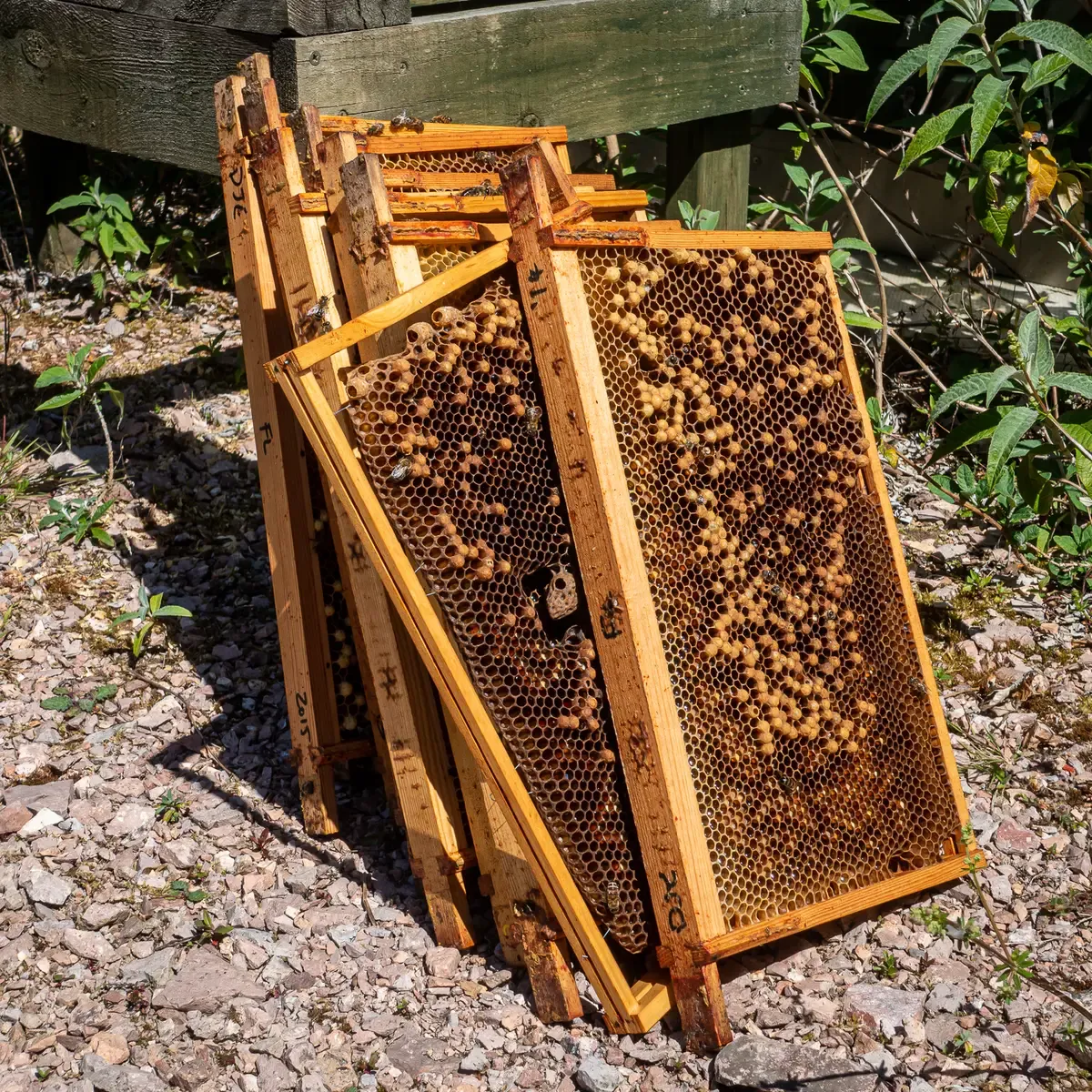
Grrrr!
In the Smith and Peck study, all colonies developed laying workers, taking an average of 32 days for their appearance to be detectable. That's around the sort of delays I've seen in my own hives, and provides an indication of when things progress from potentially 'rescuable' to problematic.
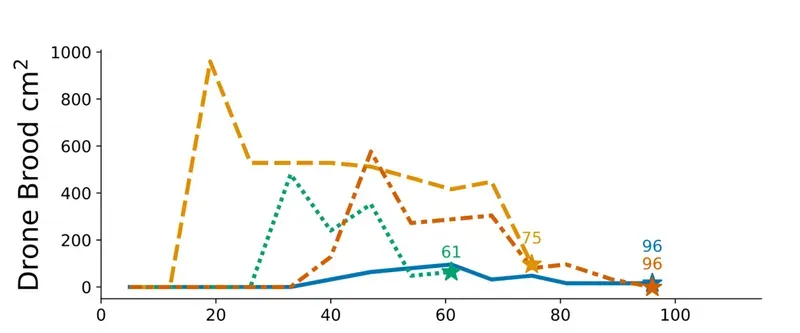
The queenless colonies produced a lot of worker-laid drone brood, occupying up to 12.5% of the available brood area.
However, very few of these drones reached maturity, with only ~3% surviving to emergence.
How does this figure compare with drones produced under other conditions?
In a queenright colony, a queen-laid drone egg has ~56% chance of emerging, whereas a worker-laid egg has only a 0.12% chance (due to the strict worker policing mentioned above).
Bear in mind that this study was conducted in the autumn. Forage was limiting and most colonies starved. Perhaps worker-laid drone brood would have a better chance of survival earlier in the season?
Although this drone brood was produced as a last gasp attempt at survival, it didn't actually help them survive (and would have been a futile gesture from October anyway 😞).
Mites and bees
Perhaps unsurprisingly, there was a direct relationship between the number of mites that dropped through the floor of the observation hives and the number of adult workers or drones in the 'terminally declining' colony. I've not bothered showing this data.
Remember that colonies lost lots of workers early on and then contained a much smaller 'tail' of bees (both workers and drones) that survived until mid/late December. During this period colonies attempted to rear drones, in the vain hope {{4}} of ensuring their genetic survival, if nothing else. However, although drone brood is much more attractive to invading phoretic mites, there was very little mite replication (as evidenced by immature mites falling through the mesh floor).
It's likely that the very small amount of worker-laid drone brood that reached maturity accounts for this limited amount of mite replication (immature mites should only appear on the floor after brood emerges).
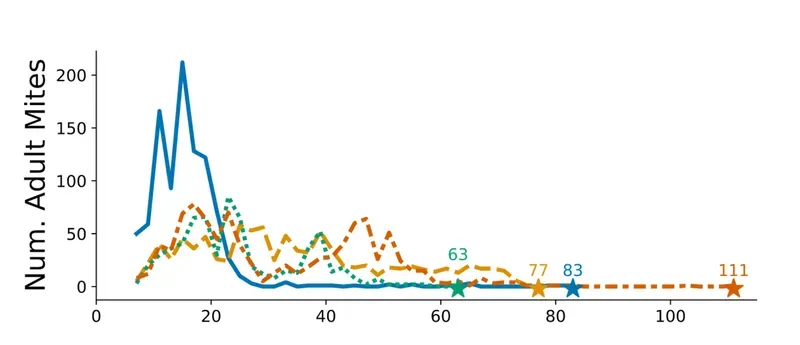
One of the four colonies reared no adult drones from worker-laid eggs. Nevertheless, all colonies contained some adult mites at or near the point (-13 to +2 days) at which the colony finally perished.
This is significant. It means that collapsing colonies - even with no active brood rearing due to laying workers - may still act as a reservoir for mites, which could be transferred during robbing to nearby strong colonies.
Two of the colonies contained live mites 48 hours after the last of the bees perished; one of these was the colony which reared no drone brood to adulthood. This means the mites had been phoretic for at least the duration of the experiment (minus the first 21 days, if they had emerged with the last of the queen-laid worker brood).
However, it's not clear (or perhaps known?) whether mites of this vintage are able to re-infest new brood if given the opportunity, or if they can reproduce after entering a cell.
Loose ends
As with any scientific study that furthers our knowledge, this one creates as many questions as it answers.
I'd have liked to see what happened to the colonies had they been rendered queenless earlier in the season, with time for the weakening colonies to be robbed. Presumably, this would hasten the demise of the queenless colony.
50% of the colony population was lost within one month. Where did the bees that disappeared go? Did they simply die; of old age, while out foraging etc. Alternatively, did they drift away to nearby queenright hives? {{5}}
Finally, and it's an important point, how reproductively fit are mites that have been phoretic for 2-3+ months?
We know mites can overwinter in colonies that are broodless for this duration. However, that's when they are associated with the 'forever young' diutinus overwintering bees. These are physiologically distinct from the tired old summer workers that probably made up the majority of the population in the study hives.
And, while we're at it, was that tail of long-lived bees different physiologically from the bees that died early? Were they actually the very first few winter bees reared in the hive? It should be possible to determine this by monitoring the levels of juvenile hormone and vitellogenin.
Implications for practical beekeeping
Although this is a small-scale study conducted at the fag-end of the beekeeping season, I think there are still some interesting lessons in it:
- terminally queenless colonies can survive for months, much longer than you would expect from the known lifespan of foragers.
- worker loss is biphasic, with many lost within the first month, and the remainder hanging on until (at least in this study) they died of starvation or cold.
- it takes about a month {{6}} for a queenless colony to develop laying workers (at least to a detectable level ... they are present all the time). This is worth remembering because 'rescuing' a queenless colony gets a lot more difficult once there are laying workers present in any number (also see note below).
- mites infesting the colony survive about as long as the bees do, so potentially act as an infestation reservoir which - when robbed - could spread to other colonies in the area.
Finally, some queens fail to mate - bad weather, no nearby drones or because they are very shy {{7}} - and the presence of an unmated queen, once she is too old to mate, effectively renders the colony terminally queenless. The colony might produce more drones as she could lay unfertilised eggs, but the decline in the colony will still be inexorable and inevitable.
Colonies like this, and I've seen a couple this Spring where the queen simply failed to start laying again, are lethargic, don't bother foraging even if the weather is good, and simply dwindle away to nothing ... and there are so few bees that they're probably not rescuable (or worth rescuing) anyway.
Keep an eye on your queens. Check whether they have mated successfully and - if not - act sooner rather than later.
Sponsorship
If you found this post or other posts useful, informative or entertaining, then please consider becoming a sponsor of The Apiarist. It costs less than £1/week and ensures you receive every newsletter, including those - like Bees in the News #2 last Wednesday, or the post next week - written for sponsors only.
Alternatively, you can delay my terminal decline by fuelling my caffeine dependency and spread the word to encourage others to subscribe.
Thank you
Notes
Steve Donoghue (The Walrus) has recently posted a study of virgin queen introduction methods. In it, they claim to have a 60% success rate in colonies with laying workers. I'll let you read Steve's coverage of the study, but this figure surprised me.
My experience and understanding is that virgin queen introduction is generally less successful (in any colony) than adding a laying queen, and I've been overwhelmingly unsuccessful in introducing laying queens to colonies with laying workers (so much so that I don't even bother trying these days).
If that 60% figure is correct, it's almost worth keeping a handful of virgin queens banked and ready should they be needed ... but that's a topic for another post entirely.
References
Abdu, M., Ali, M., and Taha, E.-K. (2012) Bee-Eating Birds (Coraciiformes: Meropidae) Reduce Virgin Honey Bee Queen Survival during Mating Flights and Foraging Activity of Honey Bees (Apis mellifera L.). .) Int J Sci Eng Res 3: 1-8
Ratnieks, F.L.W. (1990) The evolution of polyandry by queens in social Hymenoptera: the significance of the timing of removal of diploid males. Behav Ecol Sociobiol 26: 343–348 https://doi.org/10.1007/BF00171100.
Smith, M.L. (2018) Queenless honey bees build infrastructure for direct reproduction until their new queen proves her worth. Evolution 72: 2810–2817 https://onlinelibrary.wiley.com/doi/abs/10.1111/evo.13628.
Smith, M.L., and Peck, D.T. (2023) Dynamics of honey bee colony death and its implications for Varroa destructor mite transmission using observation hives. Apidologie 54: 13 https://doi.org/10.1007/s13592-023-00991-4.
{{1}}: It's also the sort of artistic licence that makes it sound like I know what I'm doing.
{{2}}: OK, I acknowledge this is unlikely in either the Arnott Forest or the UK, but will occur anywhere ratels are found i.e. Africa, Southwest Asia and India
{{3}}: This is also why queenless colonies, or those containing unmated queens, invest resources in drone production. For example, they produce more drone comb under these conditions.
{{4}}: Though that's rather too much anthropomorphising!
{{5}}: Some of this research was conducted at the Dyce Lab for Honey Bee Studies in Ithaca and I would expect there were other hives within range of the queenless observation hives.
{{6}}: The actual range was 19-42 days, with an average of 32±10 days.
{{7}}: OK, I made that last reason up.
Join the discussion ...